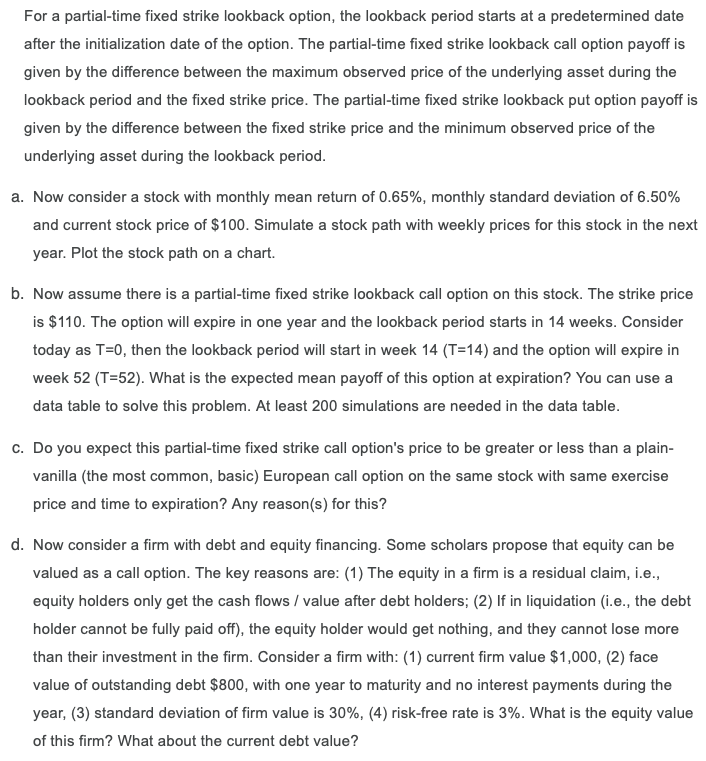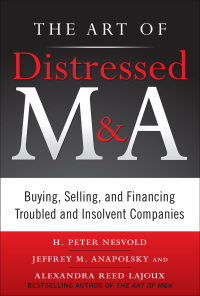
For a partial-time fixed strike lookback option, the lookback period starts at a predetermined date after the initialization date of the option. The partial-time fixed strike lookback call option payoff is given by the difference between the maximum observed price of the underlying asset during the lookback period and the fixed strike price. The partial-time fixed strike lookback put option payoff is given by the difference between the fixed strike price and the minimum observed price of the underlying asset during the lookback period. a. Now consider a stock with monthly mean return of 0.65%, monthly standard deviation of 6.50% and current stock price of $100. Simulate a stock path with weekly prices for this stock in the next year. Plot the stock path on a chart. b. Now assume there is a partial-time fixed strike lookback call option on this stock. The strike price is $110. The option will expire in one year and the lookback period starts in 14 weeks. Consider today as T=0, then the lookback period will start in week 14 (T=14) and the option will expire in week 52 (T=52). What is the expected mean payoff of this option at expiration? You can use a data table to solve this problem. At least 200 simulations are needed in the data table. c. Do you expect this partial-time fixed strike call option's price to be greater or less than a plain- vanilla (the most common, basic) European call option on the same stock with same exercise price and time to expiration? Any reason(s) for this? d. Now consider a firm with debt and equity financing. Some scholars propose that equity can be valued as a call option. The key reasons are: (1) The equity in a firm is a residual claim, i.e., equity holders only get the cash flows / value after debt holders; (2) If in liquidation (i.e., the debt holder cannot be fully paid off), the equity holder would get nothing, and they cannot lose more than their investment in the firm. Consider a firm with: (1) current firm value $1,000, (2) face value of outstanding debt $800, with one year to maturity and no interest payments during the year, (3) standard deviation of firm value is 30%, (4) risk-free rate is 3%. What is the equity value of this firm? What about the current debt value? For a partial-time fixed strike lookback option, the lookback period starts at a predetermined date after the initialization date of the option. The partial-time fixed strike lookback call option payoff is given by the difference between the maximum observed price of the underlying asset during the lookback period and the fixed strike price. The partial-time fixed strike lookback put option payoff is given by the difference between the fixed strike price and the minimum observed price of the underlying asset during the lookback period. a. Now consider a stock with monthly mean return of 0.65%, monthly standard deviation of 6.50% and current stock price of $100. Simulate a stock path with weekly prices for this stock in the next year. Plot the stock path on a chart. b. Now assume there is a partial-time fixed strike lookback call option on this stock. The strike price is $110. The option will expire in one year and the lookback period starts in 14 weeks. Consider today as T=0, then the lookback period will start in week 14 (T=14) and the option will expire in week 52 (T=52). What is the expected mean payoff of this option at expiration? You can use a data table to solve this problem. At least 200 simulations are needed in the data table. c. Do you expect this partial-time fixed strike call option's price to be greater or less than a plain- vanilla (the most common, basic) European call option on the same stock with same exercise price and time to expiration? Any reason(s) for this? d. Now consider a firm with debt and equity financing. Some scholars propose that equity can be valued as a call option. The key reasons are: (1) The equity in a firm is a residual claim, i.e., equity holders only get the cash flows / value after debt holders; (2) If in liquidation (i.e., the debt holder cannot be fully paid off), the equity holder would get nothing, and they cannot lose more than their investment in the firm. Consider a firm with: (1) current firm value $1,000, (2) face value of outstanding debt $800, with one year to maturity and no interest payments during the year, (3) standard deviation of firm value is 30%, (4) risk-free rate is 3%. What is the equity value of this firm? What about the current debt value







